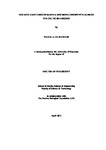MOLECULAR STUDIES OF KARENIA MIKIMOTOI (DINOPHYCEAE) FROM THE CELTIC SEA REGION
| dc.contributor.supervisor | Edwards, Martin | |
| dc.contributor.author | Al-Kandari, Manal A. | |
| dc.contributor.other | School of Biological and Marine Sciences | en_US |
| dc.date.accessioned | 2012-08-02T14:30:30Z | |
| dc.date.available | 2012-08-02T14:30:30Z | |
| dc.date.issued | 2012 | |
| dc.identifier | 10272169 | en_US |
| dc.identifier.uri | http://hdl.handle.net/10026.1/1088 | |
| dc.description.abstract |
K. mikimotoi has been classified under many names and has been mis-assigned to different species and genera in the North Atlantic and Pacific because of its morphological similarities to other Gymnodinoid species. It is now known to be widely distributed, but there remain unresolved questions about whether K. mikimotoi was introduced into the North Sea from Japanese waters, or whether it has always inhabited this region and been erroneously classified as Gymnodinium spp. or has been a part of the hidden flora prior to be recognised in a bloom off the Norwegian coast in 1966. To address questions about geographical genetic variation within K. mikimotoi and broader issues about its biogeography it was deemed important to develop a suitable diagnostic molecular marker that could then be used to monitor the presence/absence of different K. mikimotoi ecotypes over long time scales in European waters. This study showed that the partial rDNA LSU (D1-D2) was too conserved to separate the different strains of K. mikimotoi, while, the ITS region was better able to discriminate between the different strains. However, the rbcL gene was the most informative gene and contained sufficient substitutions to separate the different strains of K. mikimotoi. Specific PCR-primers were designed to amplify a variable region of the rbcL gene able to distinguish differences between K. mikimotoi isolates from the different regions. The innovative high resolution melting temperature (HRM) technique based on specific primer set allowed rapid discrimination of K. mikimotoi from distinct geographic localities (= sequence variants) that differed by only a single nucleotide. Moreover, this study used archival environmental samples collected from the Celtic Sea shelf-break region. The high resolution melting temperature assay successfully detected the European K. mikimotoi isolate within the south-western English Channel in a 1963 sample, which is prior to thefirst report of a K. mikimotoi bloom in Norwegian waters in 1966 and in the south-western English Channel in 1975 and in western Japan in 1965. HRM observations were further validated using clone libraries and sequencing. In summary, this data provided more information about the genotypes present over the analysed timescales, revealing that K. mikimotoi sub-species 2 (European and New Zealand strains) was present in south-western English Channel and south-west Ireland for over 47 years, with sub-species 1 (the Japanese isolate) being absent from all examined samples. This finding supports the hypothesis that K. mikimotoi isolates within Europe are not of Japanese origin and suggests that they are native species to the region. | en_US |
| dc.description.sponsorship | Kuwait Institute for Scientific Research | en_US |
| dc.language.iso | en | en_US |
| dc.publisher | University of Plymouth | en_US |
| dc.subject | Harmful Algae | en_US |
| dc.title | MOLECULAR STUDIES OF KARENIA MIKIMOTOI (DINOPHYCEAE) FROM THE CELTIC SEA REGION | en_US |
| dc.type | Thesis | |
| dc.identifier.doi | http://dx.doi.org/10.24382/3807 |
Files in this item
This item appears in the following Collection(s)
-
01 Research Theses Main Collection
Research Theses Main


